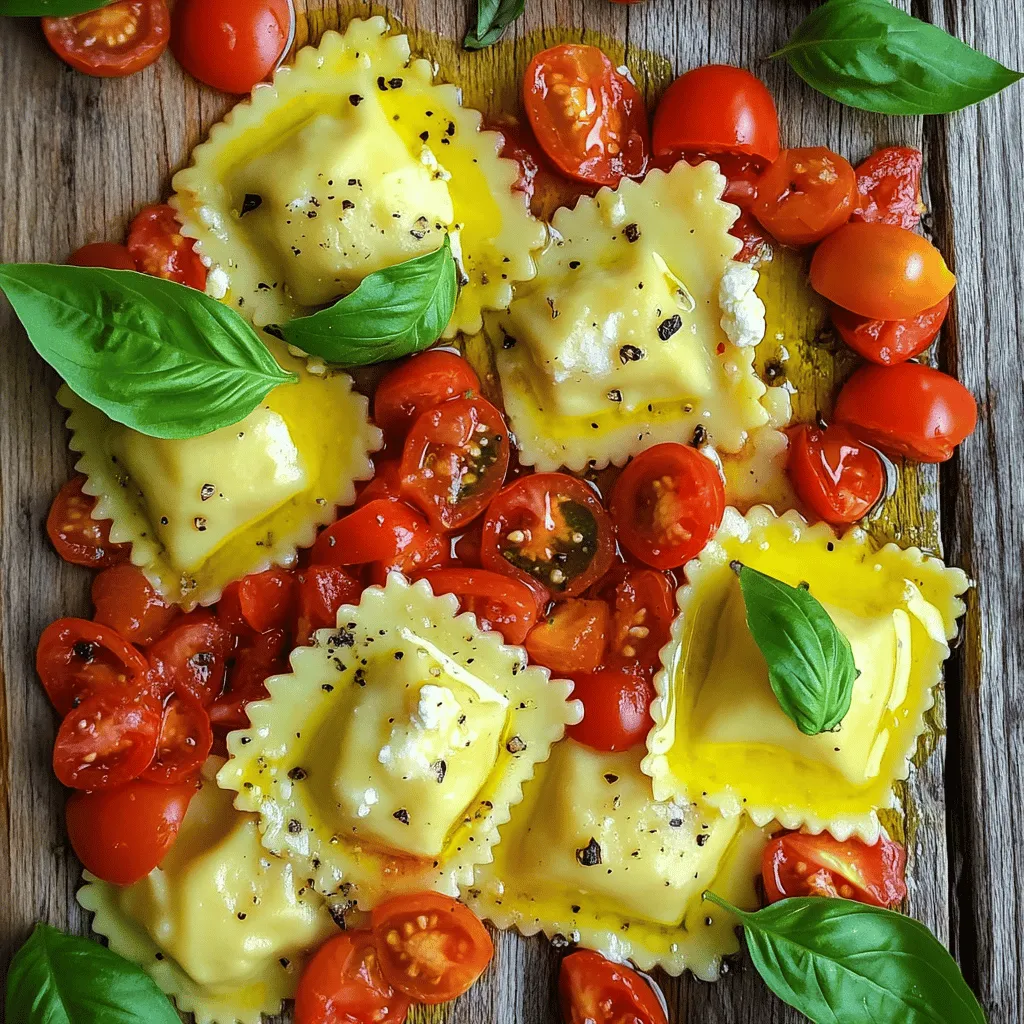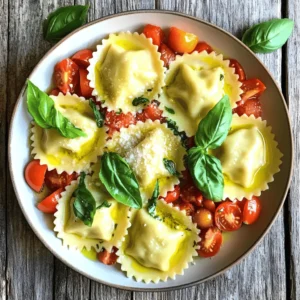If you’re ready to impress your family with something special, try this Delicious Ravioli with Fresh Tomatoes! Made from scratch, it’s a delightful blend of creamy ricotta and vibrant tomatoes. In this guide, I’ll share simple steps to create perfect ravioli at home, along with tips to enhance flavor and make it shine on your table. Join me in turning dinner into a tasty family tradition!
Ingredients
Main Ingredients
– 2 cups fresh ricotta cheese
– 1 cup grated Parmesan cheese
– 2 cups all-purpose flour (plus more for dusting)
Seasoning and Extras
– 1 teaspoon salt
– Freshly cracked black pepper to taste
– 1 tablespoon olive oil
Tomato Selection
– Heirloom Tomato Varieties
Heirloom tomatoes come in many colors and shapes. They taste sweet and juicy. Using different types adds color and flavor to your dish.
– Benefits of Fresh Tomatoes
Fresh tomatoes provide bright flavor. They are packed with vitamins. Plus, they add a lovely texture to the sauce.
– Recommendations for Substitutes
If fresh tomatoes are not available, use canned tomatoes. Look for high-quality brands. You can also try sun-dried tomatoes for a different taste.
For the full recipe, check out the details above.
Step-by-Step Instructions
Making the Ravioli Dough
Mixing Flour and Egg
Start by placing 2 cups of all-purpose flour in a bowl. Add 1 teaspoon of salt. Make a well in the center. Crack 1 egg into the well. Using a fork, mix the egg with the flour slowly.
Kneading Technique
Once mixed, take the dough out. Knead it by hand for 5-7 minutes. You want it smooth and elastic. If it feels sticky, dust it with a bit more flour.
Resting Time
Wrap the dough in plastic wrap. Let it rest at room temperature for 30 minutes. This helps the gluten relax, making it easier to roll out later.
Preparing the Ravioli Filling
Combining Cheese and Seasoning
In a bowl, mix 2 cups of fresh ricotta cheese and 1 cup of grated Parmesan cheese. Add 1 egg, a pinch of salt, and freshly cracked black pepper. Stir well until creamy.
Importance of Consistency
Your filling should be smooth and thick. Avoid it being too runny, as it can leak out when cooking.
Storing Filling for Later Use
If you want to save some filling, store it in an airtight container. It will keep well in the fridge for up to two days.
Rolling and Shaping the Ravioli
Techniques for Rolling Dough Thin
After resting, divide the dough into four pieces. Roll one piece on a floured surface until it’s thin, about 1/16 inch. Keep the other pieces covered to prevent drying.
Creating Filling Mounds
Once rolled, spoon teaspoons of filling onto the dough. Space the filling about 2 inches apart.
Sealing and Cutting Ravioli
Moisten the dough edges around each mound with water. This helps seal them. Place another layer of dough over the filling. Press around each mound to remove air. Cut out the ravioli shapes using a knife or pastry cutter.
For the full recipe, refer to the main article.
Tips & Tricks
Common Mistakes to Avoid
– Overworking Dough: Knead your dough just enough. If you knead too much, it gets tough. Keep it soft and smooth.
– Not Sealing Ravioli Properly: It’s key to seal your ravioli tight. If not, the filling can leak out during cooking. Use water on the edges to help seal.
– Cooking Times: Don’t overcook your ravioli. They only need 3-4 minutes in boiling water. When they float, they are ready.
Enhancing Flavor
– Using Fresh Herbs: Fresh herbs like basil can boost flavor. Add them to your sauce or filling for a fragrant touch.
– Alternative Cheeses: Try mixing different cheeses in your filling. Mozzarella or goat cheese adds a nice twist. Experiment to find your favorite blend.
– Adjusting Seasoning: Taste as you go! Add salt, pepper, or even a pinch of red pepper flakes for heat. Adjust to fit your family’s taste.
Presentation Tips
– Plating Techniques: Use deep bowls for a nice look. Layer your ravioli in the center and spoon sauce around them.
– Garnishing Ideas: Fresh basil leaves or a sprinkle of Parmesan make a lovely garnish. A drizzle of olive oil adds shine and flavor.
– Serving Suggestions: Serve ravioli with a side salad or crusty bread. This pairs well and makes for a hearty meal.
These tips will help you create a stunning and tasty dish. For the complete details, check the Full Recipe.

Variations
Different Fillings to Try
You can change the filling in your ravioli to make it unique.
– Meat-Based Fillings: You can use ground beef or pork mixed with herbs. This adds a rich flavor. Try adding some spinach for extra taste and nutrition.
– Vegetable Options: Use chopped mushrooms, spinach, or zucchini. These veggies add color and flavor. Blend them with cheese for a creamy texture.
– Vegan Adaptations: For a vegan twist, use mashed tofu and fresh herbs. This keeps the ravioli tasty and plant-based. You can also use lentils for protein.
Sauce Pairings
The sauce you choose can change the whole dish.
– Alternative Sauces for Ravioli: Besides tomato sauce, try brown butter or sage sauce. It gives a nutty flavor that complements the ravioli.
– Creamy Sauces vs. Tomato-Based: Creamy sauces are rich and smooth. Tomato-based sauces are bright and fresh. You can mix them for a unique taste.
– Pesto Options: Pesto adds a burst of flavor. You can use basil pesto, or try sun-dried tomato pesto for a twist.
Serving Styles
How you serve your ravioli can make it special.
– Ravioli as a Main Dish: Serve it with a side salad for a full meal. This makes it filling and balanced.
– Appetizer Ideas: Cut the ravioli into smaller pieces. Serve with dipping sauces for a fun appetizer.
– Pairings with Sides: Pair ravioli with garlic bread or roasted vegetables. This adds texture and flavor to your meal.
Explore the full recipe to discover how to make these tasty variations at home.
Storage Info
Storing Cooked Ravioli
Refrigeration Guidelines
Once you cook your ravioli, you can store them in the fridge. Place them in a shallow container. Cover the container with a lid or plastic wrap. They will stay fresh for up to three days. Make sure they cool down before sealing to avoid steam buildup.
Freezing Techniques
If you want to keep them longer, freezing is a great option. Lay the cooked ravioli in a single layer on a baking sheet. Freeze them for about an hour. After they are firm, transfer them to a freezer bag. Remove as much air as possible. They can last for up to three months in the freezer.
Storing Uncooked Ravioli
Best Practices for Preservation
If you have leftover uncooked ravioli, store them carefully. Dust them with flour to prevent sticking. Arrange them in a single layer on a baking sheet and freeze until firm. Once frozen, transfer them to an airtight container. They will stay good for up to two months.
Recommended Containers
For storing uncooked ravioli, use a rigid plastic container or a freezer bag. If using a bag, remove as much air as possible before sealing. Label the container with the date. This helps you keep track of freshness.
Reheating Tips
Best Methods for Reheating
To reheat cooked ravioli, the best method is to use a skillet. Heat a little olive oil over medium heat. Add the ravioli and a splash of water. Cover the pan and let them steam for a few minutes. This keeps them moist and warm.
Avoiding Overcooking
Be careful not to overcook the ravioli while reheating. Check them after a few minutes. They should be warm but not mushy. If they start to fall apart, you’ve cooked them too long. Enjoy your ravioli fresh, even after storage!
FAQs
How long does it take to make ravioli from scratch?
Making ravioli from scratch takes about 1 hour and 15 minutes. This includes 45 minutes for prep and 30 minutes for cooking. You should account for resting time too. The dough needs to rest for 30 minutes. If you let it rest, it will be easier to roll out.
Can I use store-bought ravioli for this recipe?
Yes, you can use store-bought ravioli. They save time and still taste good. However, the sauce may need adjustments. Store-bought ravioli often have strong flavors. You might want to reduce the seasoning in your sauce to balance the dish.
What types of tomatoes are best for ravioli sauce?
Heirloom tomatoes work best for ravioli sauce. They have rich flavors and juicy textures. Cherry, Roma, and beefsteak tomatoes are great choices. Look for tomatoes that are firm with vibrant colors. Avoid any that feel soft or have blemishes. Fresh tomatoes bring lots of flavor to your dish.
Is it possible to freeze cooked ravioli?
Yes, you can freeze cooked ravioli. To freeze, place them on a baking sheet in a single layer. Once frozen, transfer them to an airtight container. To reheat, place them in boiling water for a few minutes until hot. This method keeps them from getting mushy.
Making ravioli from scratch is rewarding and fun. We discussed key ingredients, from rich ricotta to fresh heirloom tomatoes. I shared step-by-step instructions for perfect dough and filling. You learned tips to avoid common mistakes and how to enhance flavors. We explored variations and storage options for cooked and uncooked ravioli.
Take these skills to create delicious meals. Homemade ravioli brings joy to your table. Enjoy experimenting and sharing your creations!

